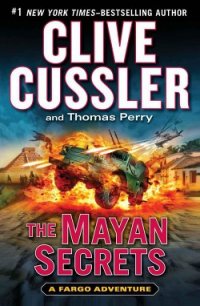Digital Fortess - Brown Dan (читать книги онлайн без сокращений TXT) 📗
“You will receive both pass?keys,” the voice said. “Mr. Tankado’s and mine.”
Numataka covered the receiver and laughed aloud. He couldn’t help asking. “How much are you asking for both keys?”
“Twenty million U.S. dollars.”
Twenty million was almost exactly what Numataka had bid. “Twenty million?” He gasped in mock horror. “That’s outrageous!”
“I’ve seen the algorithm. I assure you it’s well worth it.”
No shit, thought Numataka. It’s worth ten times that. “Unfortunately,” he said, tiring of the game, “we both know Mr. Tankado would never stand for this. Think of the legal repercussions.”
The caller paused ominously. “What if Mr. Tankado were no longer a factor?”
Numataka wanted to laugh, but he noted an odd determination in the voice. “If Tankado were no longer a factor?” Numataka considered it. “Then you and I would have a deal.”
“I’ll be in touch,” the voice said. The line went dead.
CHAPTER 14
Becker gazed down at the cadaver. Even hours after death, the Asian’s face radiated with a pinkish glow of a recent sunburn. The rest of him was a pale yellow?all except the small area of purplish bruising directly over his heart.
Probably from the CPR, Becker mused. Too bad it didn’t work.
He went back to studying the cadaver’s hands. They were like nothing Becker had ever seen. Each hand had only three digits, and they were twisted and askew. The disfigurement, however, was not what Becker was looking at.
“Well, I’ll be.” The lieutenant grunted from across the room. “He’s Japanese, not Chinese.”
Becker looked up. The officer was thumbing through the dead man’s passport. “I’d rather you didn’t look at that,” Becker requested. Touch nothing. Read nothing.
“Ensei Tankado . . . born January—”
“Please,” Becker said politely. “Put it back.”
The officer stared at the passport a moment longer and then tossed it back on the pile. “This guy’s got a class?3 visa. He could have stayed here for years.”
Becker poked at the victim’s hand with a pen. “Maybe he lived here.”
“Nope. Date of entry was last week.”
“Maybe he was moving here,” Becker offered curtly.
“Yeah, maybe. Crummy first week. Sunstroke and a heart attack. Poor bastard.”
Becker ignored the officer and studied the hand. “You’re positive he wasn’t wearing any jewelry when he died?”
The officer looked up, startled. “Jewelry?”
“Yeah. Take a look at this.”
The officer crossed the room.
The skin on Tankado’s left hand showed traces of sunburn, everywhere except a narrow band of flesh around the smallest finger.
Becker pointed to the strip of pale flesh. “See how this isn’t sunburned here? Looks like he was wearing a ring.”
The officer seemed surprised. “A ring?” His voice sounded suddenly perplexed. He studied the corpse’s finger. Then he flushed sheepishly. “My God.” He chuckled. “The story was true?”
Becker had a sudden sinking feeling. “I beg your pardon?”
The officer shook his head in disbelief. “I would have mentioned it before . . . but I thought the guy was nuts.”
Becker was not smiling. “What guy?”
“The guy who phoned in the emergency. Some Canadian tourist. Kept talking about a ring. Babbling in the worst damn Spanish I ever heard.”
“He said Mr. Tankado was wearing a ring?”
The officer nodded. He pulled out a Ducado cigarette, eyed the no fumar sign, and lit up anyway. “Guess I should have said something, but the guy sounded totally loco.”
Becker frowned. Strathmore’s words echoed in his ears. I want everything Ensei Tankado had with him. Everything. Leave nothing. Not even a tiny scrap of paper.
“Where is the ring now?” Becker asked.
The officer took a puff. “Long story.”
Something told Becker this was not good news. “Tell me anyway.”
CHAPTER 15
Susan Fletcher sat at her computer terminal inside Node 3. Node 3 was the cryptographers’ private, soundproofed chamber just off the main floor. A two?inch sheet of curved one?way glass gave the cryptographers a panorama of the Crypto floor while prohibiting anyone else from seeing inside.
At the back of the expansive Node 3 chamber, twelve terminals sat in a perfect circle. The annular arrangement was intended to encourage intellectual exchange between cryptographers, to remind them they were part of a larger team?something like a code?breaker’s Knights of the Round Table. Ironically, secrets were frowned on inside Node 3.
Nicknamed the Playpen, Node 3 had none of the sterile feel of the rest of Crypto. It was designed to feel like home?plush carpets, high?tech sound system, fully stocked fridge, kitchenette, a Nerf basketball hoop. The NSA had a philosophy about Crypto: Don’t drop a couple billion bucks into a code?breaking computer without enticing the best of the best to stick around and use it.
Susan slipped out of her Salvatore Ferragamo flats and dug her stockinged toes into the thick pile carpet. Well?paid government employees were encouraged to refrain from lavish displays of personal wealth. It was usually no problem for Susan?she was perfectly happy with her modest duplex, Volvo sedan, and conservative wardrobe. But shoes were another matter. Even when Susan was in college, she’d budgeted for the best.
You can’t jump for the stars if your feet hurt, her aunt had once told her. And when you get where you’re going, you darn well better look great!
Susan allowed herself a luxurious stretch and then settled down to business. She pulled up her tracer and prepared to configure it. She glanced at the E?mail address Strathmore had given her.
[email protected]
The man calling himself North Dakota had an anonymous account, but Susan knew it would not remain anonymous for long. The tracer would pass through ARA, get forwarded to North Dakota, and then send information back containing the man’s real Internet address.
If all went well, it would locate North Dakota soon, and Strathmore could confiscate the pass?key. That would leave only David. When he found Tankado’s copy, both pass?keys could be destroyed; Tankado’s little time bomb would be harmless, a deadly explosive without a detonator.
Susan double?checked the address on the sheet in front of her and entered the information in the correct data field. She chuckled that Strathmore had encountered difficulty sending the tracer himself. Apparently he’d sent it twice, both times receiving Tankado’s address back rather than North Dakota’s. It was a simple mistake, Susan thought; Strathmore had probably interchanged the data fields, and the tracer had searched for the wrong account.
Susan finished configuring her tracer and queued it for release. Then she hit return. The computer beeped once.
TRACER SENT.
Now came the waiting game.
Susan exhaled. She felt guilty for having been hard on the commander. If there was anyone qualified to handle this threat single?handed, it was Trevor Strathmore. He had an uncanny way of getting the best of all those who challenged him.
Six months ago, when the EFF broke a story that an NSA submarine was snooping underwater telephone cables, Strathmore calmly leaked a conflicting story that the submarine was actually illegally burying toxic waste. The EFF and the oceanic environmentalists spent so much time bickering over which version was true, the media eventually tired of the story and moved on.
Every move Strathmore made was meticulously planned. He depended heavily on his computer when devising and revising his plans. Like many NSA employees, Strathmore used NSA?developed software called BrainStorm?a risk?free way to carry out “what?if” scenarios in the safety of a computer.
BrainStorm was an artificial intelligence experiment described by its developers as a Cause Effect Simulator. It originally had been intended for use in political campaigns as a way to create real?time models of a given “political environment.” Fed by enormous amounts of data, the program created a relationary web?a hypothesized model of interaction between political variables, including current prominent figures, their staffs, their personal ties to each other, hot issues, individuals’ motivations weighted by variables like sex, ethnicity, money, and power. The user could then enter any hypothetical event and BrainStorm would predict the event’s effect on “the environment.”




